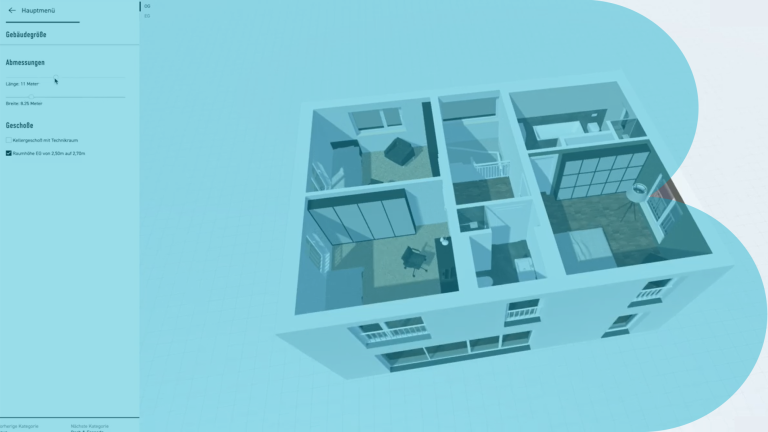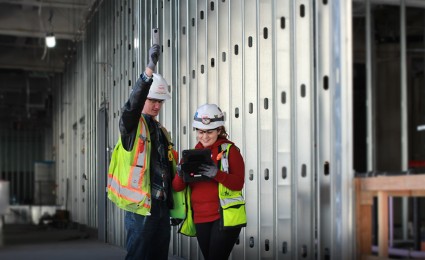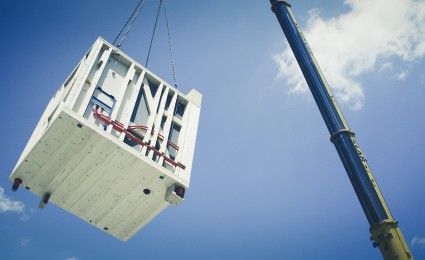Interested in other interviews of the series? Click here!


Construction Startup Radar
Bringing a complete value-chain management solution to the residential construction market
A German home design startup saw a chance in an obvious – and underserved – market
For those in residential construction, the inefficiency in time and cost caused by the disconnected processes – as well as the lack of owner oversight – involved in taking a building from blueprint to completed project is well known. For German startup Mr + Mrs Homes, this presented a window of opportunity to innovate a software-based turnkey solution highly relevant to the needs of those building their own home. Co-founder Mario Mirbach joined us recently to discuss the platform and how the solution fits into the bigger picture of digitization in the construction sphere.

"For the first time, the building owner gets planning and budget skills in a one-stop solution."
Let’s start with introductions and hearing a bit about your background.
Markus Semmelmann and myself, Mario Mirbach, are the founders, and for the past 10 years we have been running an architectural office with 25 team members. We are an established firm with expertise in home construction. We have planned over 800 residential units of single-family and multi-story apartments. With the use of partial automation in the first phase, our architecture team is set up to easily handle 500 Mr + Mrs Homes projects per year.
Our IT team is very experienced and competent, and is ready to develop further home models with an ever-expanding range of functions.
As a strategic partner, PURE Applikationen GmbH & Co.KG included BayWa AG in the group of shareholders. As an innovative building materials dealer, BayWa provides the operational interface to manufacturers and general contractors, thereby strategically expanding their range of services for their customer base.
What does your company and business model do differently than other startups in the industry?
The Mr + Mrs Homes platform offers an online 3D house configurator that can be used to assemble a house from thousands of variants and in real-time preview all of these variant related prices. Furthermore, it provides all approval and execution documents as soon as the building owner and general contractor have signed the contract.
In the primary business model, the general contractor pays for the use of the configurator as well as all additional, partially automated, planning services for each project.
The builder’s free use of the digitally automated process of design offers a cost calculating phase that shows a real-time and transparent price preview, differentiating what Mr + Mrs Homes offers by comparison to other architectural prefab and turnkey models in the construction market. There are no other startups that offer a comparable range of functions and services that Mr + Mrs Homes offers.

What inspired the idea for your company?
This business idea was born in 2015 along the lines of the automotive configurators. Clients’ demands regarding design, size and other variants rarely match an existing budget, thus our motivation to rethink the process of single-family home planning. Also, only 5% of all residential buildings are planned by architects, because typically an architect's fee is not fully covered within budgets for homes in the price range of € 300,000 to 500,000. For the first time, the building owner is provided with competent planning and budget skills in a one-stop solution from a process-oriented single source that combines the advantages of complete digitalization with turnkey construction (a one-stop solution from a single source) and reliable architectural planning.
Which types of clients are most important to your business?
Our platform combines three customer groups. The first is the end customer – the building owner – who intends to build a single-family home. Then there’s the turnkey contractor, whose planning, calculation, and acquisition process is being fully digitized by us. Thirdly we have the manufacturers of building materials and construction products, for whom the platform constitutes a further digital and direct sales channel.
It’s often thought that it’s more difficult for construction startups than others to receive funding. How does this hold with your experience?
There were certainly some reservations about implementing this ambitious business idea and having it ready for the market. The demand and the opportunities of such a solution, seen by three target groups, was an influential seed during the development phase. The economies of scale, particularly in product marketing, as well as in the pre-planning and calculation process of our business model, are already effective. However, in the interest of the end customer, we have deliberately decided to integrate the construction and thus the engineering and detailed planning. A client’s goal is to move in to their own home and not worry about the construction planning and costing details. In this respect, we distance ourselves from being a purely digital marketing and planning tool.
The economies of scale might be higher in other business areas; however, we are able to extend our value chain and accompany the customer through construction to building occupancy. This is difficult to convey to investors outside the construction industry; therefore, we feel fortunate to have won BayWa as a strategic partner from the construction industry. Rethinking away from high scalability with low added value towards long-term value chains can be a solution to promote innovations in the construction industry .
How do you see the construction industry looking in 2025?
For years, the CAD industry has basically been working on optimizing outdated technologies. 90% of the planning is carried out in 2D. BIM (Building Information Modeling) as a new way of working is still in its infancy in Germany. Only a few users take advantage of the great benefits of this kind of planning process, though there are very limited interfaces existing towards the construction site. For centuries, it has been standard to use 2D plans as basis for the construction work. The construction industry puts its hope in prefabrication of components and cubicles. The market will remain, but modularity is also not based on modern processes and structures, and there is virtually no demand among planners and end customers for uniform structures. Without investments in these new technologies, and as long as good profits are still achieved in all value chains of the construction sector, I personally do not expect major changes in the construction industry by 2025.
If you ask me, I would like to see a start-to-finish transparent digital process: Cloud-based, object-oriented, parametric and collaborative planning tools with output of production data for partial prefabrication or robotics. Also, laser projected plan displays on construction sites that output augmented reality for still necessary manual construction activities. I conceive of a paperless construction site with up-to-date planning statuses fed by the digital building version. The industry needs the simplest tools for planning and implementation, not only to minimize errors but also to solve the shortage of skilled workers. It is a long list of wishes, and without an influx of funding into the development of these new technologies from a political framework and subsidies, minimal progress can be expected in the next years.
In your view, what is the role of digitalization in the construction industry, e.g. to improve productivity, to increase safety or to offer entirely new building solutions?
I see an increase in productivity with standardized interfaces from integral 3D planning data models to production — whether it is mechanical or manual via projection-based displays, such as laser projections or augmented reality. Also, construction progress software with immediate connection to the supply chain for construction products or building materials, just-in-time delivery and lean management will bring noticeable productivity improvements by means of app support.
Parametric CAD with transfer to or integration of building simulations to optimize energy requirements, building statics, or building physics can certainly push the boundaries of what is feasible towards new building solutions — especially for renewable building materials. Regarding the megatrend of resource conservation: object-oriented planning that can simulate the ecological footprint of all components and optimize them via Artificial Intelligence would bring high efficiency and effectiveness in sustainable construction methods beyond political requirements or certificates.
What are the key trends you see in this context?
A consistent BIM planning process with component-specific modeling is a fundamental basis for some of these solutions. This trend has already been emerging for several years. Process-optimized isolated solutions for project management are transferred from other industries. Smartphones and iPads are increasingly used in construction site management and documentation. Although AI applications are not yet a significant trend in the industry, simulation applications are quite conceivable in order to optimize reinforcement and structure, installation, or ventilation design.
What is your 5-year company company vision?
Initially, our range will remain focused on private home construction, although the technology is also suitable for residential apartment or office buildings on greenfield sites. Our intention is to establish Mr + Mrs Homes as the platform for private home building in Germany and Austria, providing the systems partners with simple and error-free performance interfaces during the construction process.
Startups are usually some of the faster moving players in business. What’s your next goal?
The immediate goal for 2020/2021 is to integrate with additional manufacturers to join in to the marketing offer, connecting system partners for the realization of buildings throughout the German regions of Bavaria, Baden Württemberg, Hesse, and Saxony.
Who were your partners in achieving these goals?
As a building materials dealer and our co-partner, BayWa, creates the operational interface to manufacturers and general contractors. An additional strategic partner will be helpful for the roll out of the Germany-wide business.
What kind of investments do your clients need to make to get started working with your solution?
Our offer is free of charge for the end customers — the building owners. The system partners of Mr + Mrs Homes invest with a basic fee and their time to participate in an onboarding process of training and updating their pricing and conditions.
To close us out, what is your favorite anecdote to tell about startup life in the construction industry?
As architects in the construction industry for almost 30 years, and with our former education as draftsmen, some of the typical statements we hear are, "We have always done it this way" or, "Can you send me the documents by telefax?”. However, one of the greatest challenges was to prepare and convey the structural requirements in an understandable way to the IT team. In our view, specific industry software must be guided by the industry yet be inspired by influences outside of the industry. The key to a startup's success is to completely redefine the planning process, be open to new ideas, and leave existing ways of thinking behind.
Name: Mario Mirbach
Company: Mr + Mrs Homes
Website:
www.mrmrshomes.de
Founding year: 2015
Headquarters: Regensburg, Germany
Stay up-to-date with the newest happenings in the world of digital construction by signing up for our monthly newsletter. Get news on our current featured start-up and the latest relevant updates delivered straight to your inbox.






